#garments supplier canada
Explore tagged Tumblr posts
Text
Determine Who to Trust as Canada Leading Apparel Provider

Regarding Canadian suppliers of high-quality apparel, Alanic.Clothing is among the greatest. Retailers, companies, and individual consumers nationwide increasingly choose Alanic Clothing because of its dedication to high-quality textiles, fashionable designs, and environmentally friendly production methods. Alanic apparel provides a wide choice of products to meet different demands, whether you're seeking for casual wear, activewear, or custom apparel solutions.
Why Alanic Clothing is a Top clothing supplier in canada
1. A Vast Selection of Clothing
Alanic Clothing offers a wide range of clothing, such as business attire, casual wear, sportswear, and fitness wear. They are a popular option for many companies searching for high-quality wholesale apparel in Canada because of their capacity to serve a variety of markets.
2. Innovation in Fabrics and Superior Quality
Alanic Clothing prioritizes cutting-edge designs and high-performance textiles. Their clothing guarantees breathability, comfort, and durability, making it a reliable brand for consumers looking for premium clothes.
3. Ethical and Sustainable Production
Alanic Clothing is dedicated to ethical and sustainable manufacture, utilizing organic textiles and eco-friendly dyes in response to the growing demand for eco-friendly fashion.
4. Personalization and Bulk Solutions
With a focus on wholesale supplies and personalized clothing, Alanic Clothing provides companies with bulk buying, private labeling, and customizable designs.
Alanic Clothing's customer-focused, sustainable, and high-quality services are revolutionizing the Canadian apparel market. Alanic.Clothing is a reliable source for fashionable and environmentally friendly clothing, regardless of your level of experience as a store.
#clothing manufacturer in canada#clothing manufacturers canada#clothing wholesale canada#wholesale apparel canada#garments supplier canada#canada clothing wholesale#dress manufacturer in canada#wholesale clothing manufacturer in canada
0 notes
Photo
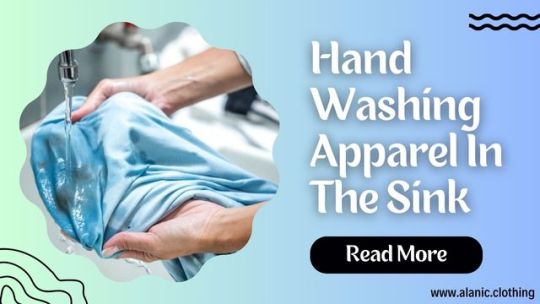
Hand-washing Apparel In The Sink: How To Do It In The Right Way
It’s a very easy method. Just remember these points mentioned in this blog, Read now.
#Hand-washing Apparel In The Sink#clothing manufacturers in Germany#Wholesale Clothing Suppliers Canada#Best Garment Manufacturers In Germany#Canadian Wholesale Clothing Suppliers
0 notes
Text
Shivangi Clothing: The Leading Wholesale Supplier of Pattu Pavadai and Half Sarees in India and Beyond
In the vibrant world of ethnic wear, Shivangi Clothing has emerged as a trusted and leading wholesale supplier of Pattu Pavadai and Half Sarees, catering to customers across India and around the globe. With a legacy rooted in tradition and a keen eye on contemporary trends, Shivangi Clothing is a name synonymous with elegance, quality, and unmatched craftsmanship.
Why Choose Shivangi Clothing?
Authenticity in Every Stitch: At Shivangi Clothing, each Pattu Pavadai and Half Saree is meticulously crafted using the finest silk and materials, ensuring the richness of tradition and durability. We pride ourselves on offering garments that celebrate the timeless charm of Indian ethnic wear.
Extensive Product Range: Our collection features an array of designs, colors, and sizes to suit the diverse needs of our customers. Whether you’re a retailer, reseller, or a boutique owner, Shivangi Clothing has something for everyone.
Competitive Pricing: Being a wholesale supplier, we provide competitive pricing without compromising on quality. This makes Shivangi Clothing the preferred choice for bulk buyers in India and abroad.
Global Reach: Shivangi Clothing isn't just a household name in India. Our reach extends across international borders, delivering premium ethnic wear to customers in the USA, UK, Canada, Singapore, and the Middle East.
Tailored to Trends: While deeply rooted in tradition, our designs also incorporate modern trends, ensuring our products appeal to all generations.
Our Signature Products
Pattu Pavadai: Known for their grace and charm, our Pattu Pavadai collections are a blend of traditional silk fabrics and contemporary patterns. Perfect for special occasions, festivals, and weddings, these ensembles capture the essence of South Indian heritage.
Half Sarees: Our Half Saree collection is designed for young women who embrace tradition with a touch of modernity. These sarees come in vibrant colors, intricate embroidery, and high-quality fabrics that make every event memorable.
Wholesale Advantages with Shivangi Clothing
Bulk Order Discounts: Get the best deals when you purchase in bulk.
Reliable Logistics: We ensure timely delivery to both domestic and international locations.
Customization Options: Create unique collections by collaborating with our in-house designers.
Dedicated Support: Our customer support team is always ready to assist with inquiries and orders.
Empowering Retailers Worldwide
By choosing Shivangi Clothing, you’re not just investing in premium ethnic wear; you’re also partnering with a reliable supplier committed to your growth. Our wholesale business model is designed to help retailers and resellers flourish in their markets by providing them with superior products and services.
How to Partner with Shivangi Clothing?
Reach Out to Us: Connect with our team via phone, email, or WhatsApp to discuss your requirements.
Browse Our Catalog: Explore our latest collections and choose the styles that suit your customers.
Place Your Order: Enjoy a seamless and hassle-free ordering process.
0 notes
Text
"Top Imports in Europe: Key Products and Trends Driving Trade"
Europe stands as a global economic powerhouse, characterized by its dynamic trade relationships and diverse import portfolio. The continent’s imports are shaped by its industrial, technological, and consumer demands, making it a major player in the international trade market. Among the key imports europe products imported into Europe are energy resources, electronic goods, vehicles, and textiles, all of which reflect the continent's reliance on external sources to sustain its industries and lifestyles. Energy resources, particularly crude oil and natural gas, dominate the import landscape, with countries like Russia, Norway, and the United States being primary suppliers. These imports are essential for Europe's energy-intensive manufacturing sectors and for meeting the heating and electricity needs of its population, especially during colder months. Despite efforts to diversify energy sources and transition to renewables, fossil fuels remain a cornerstone of European imports.
Electronics represent another significant category, with Europe importing a substantial volume of semiconductors, computers, and communication devices, primarily from Asian countries such as China, South Korea, and Japan. These products are crucial for the continent’s technology sectors, including automotive, aerospace, and telecommunications industries, which depend on cutting-edge components to remain globally competitive. Similarly, vehicle imports, including passenger cars, trucks, and automotive parts, play a vital role in meeting domestic demand and sustaining Europe’s vibrant car markets. While Europe itself is a hub for automotive production, imports fill gaps in consumer preferences and ensure the availability of luxury and economic vehicle options across its diverse population.
Textiles and apparel are also noteworthy, reflecting the fashion-conscious nature of European consumers and the region's position as a global fashion hub. Countries like Bangladesh, Vietnam, and Turkey are key suppliers, providing a steady stream of ready-made garments and raw materials. These imports support not only the retail sector but also high-end fashion industries that dominate cities such as Paris, Milan, and London. Additionally, agricultural products, including coffee, cocoa, and tropical fruits, form a crucial part of Europe’s import profile, with regions like South America, Africa, and Asia supplying these goods. The continent's culinary and beverage industries heavily rely on these imports to cater to its diverse tastes and traditions.
Trade trends in Europe also reflect broader global dynamics. Increasingly, sustainability considerations are influencing import decisions, with a growing emphasis on sourcing goods responsibly and reducing the carbon footprint of trade. The COVID-19 pandemic and geopolitical tensions have further reshaped Europe’s import landscape, pushing countries to reassess supply chains, diversify sourcing, and invest in local production capabilities. Free trade agreements and partnerships, such as those with Canada (CETA) and Japan (EPA), have further expanded access to diverse goods while reducing trade barriers.
In conclusion, Europe's import patterns are a testament to its integration into the global economy and its role as a consumer-driven market. From energy and technology to textiles and agriculture, the continent’s imports not only fulfill essential needs but also highlight the intricate interdependence of international trade. As Europe navigates challenges such as climate change, political shifts, and economic uncertainty, its import trends will likely continue to evolve, reflecting both local priorities and global developments.
1 note
·
View note
Text
Why You Should Buy Ethnic Outfits Locally in Canada
1. Convenience and Accessibility
Shopping locally means instant access to your desired ethnic outfits. You no longer need to wait for months until your next trip back home. Canadian cities, especially metropolitan areas like Toronto, Vancouver, and Montreal, have a plethora of ethnic clothing stores offering a wide variety of styles, from traditional to contemporary.
2. Supporting Local Businesses

Purchasing ethnic wear from local stores helps support small businesses and contributes to the Canadian economy. Many of these businesses are run by immigrants who bring their rich heritage and craftsmanship to Canada. By shopping locally, you are helping these businesses thrive and sustain their cultural contributions to the community.
3. Tailored to Local Trends and Needs
Local stores often cater to the unique needs of their clientele, blending traditional designs with modern trends that appeal to the diaspora. They understand the Canadian climate and lifestyle, offering outfits that are suitable for various weather conditions and occasions specific to the local community.
4. Quality and Authenticity
Canadian ethnic wear stores pride themselves on offering high-quality and authentic garments specially kurtapyjama.ca as they carry layest fashion outfits and source their materials from reputable suppliers and ensure that the craftsmanship meets high standards. You can personally check the fabric, fit, and finish before making a purchase, ensuring that you get the best value for your money.
5. Customization and Alterations
Local boutiques frequently offer customization and alteration services, ensuring that your outfit fits you perfectly. This is particularly useful for events where a flawless fit is essential. Tailors in these stores are experienced in handling ethnic garments and can make adjustments that cater to your specific preferences and body type.
6. Avoiding Shipping Hassles
Ordering ethnic wear from back home often involves international shipping, which can be both expensive and unreliable. By buying locally, you avoid the risk of delays, customs issues, or damage during transit. You get to walk out of the store with your purchase in hand, ready to wear.
7. Building Community Connections
Shopping locally can also be a social experience. You get to meet and interact with others who share your cultural background, fostering a sense of community. Store owners and staff are often knowledgeable about cultural traditions and can provide valuable advice on styling and accessorizing your outfits for various occasions.
8. Environmental Benefits
By purchasing locally, you reduce the carbon footprint associated with shipping goods internationally. This environmentally friendly choice supports sustainable practices and reduces the overall impact on the planet.
Conclusion
Buying your ethnic outfits locally in Canada offers numerous benefits, from convenience and quality assurance to supporting local businesses and reducing environmental impact. Next time you need a traditional outfit, consider exploring the vibrant ethnic wear market right in Canada. Not only will you find beautiful and unique garments, but you’ll also be contributing to a thriving cultural community right at home.
0 notes
Text
Top 10 Exports of Bangladesh

Bangladesh has transformed its export sector, leveraging its potential to achieve record-breaking trade figures each year. The country's robust garment industry, combined with low labor costs and inexpensive raw materials, has positioned Bangladesh as a critical supplier in the global market. This article explores the top exports of Bangladesh, key export destinations, and prominent Bangladeshi exporting companies.
Bangladesh's Export Performance in 2023-24
According to the economic complexity index, Bangladesh was the 52nd largest exporter globally in 2023-24. The country has solidified its position as a leading exporter of textile scrap, jute yarn, textile fiber, and men's shirts. According to Bangladesh export data, total exports in Bangladesh reached an all-time high of 361 billion in 2023-24 compared to 62.2 billion in 2022-23.
Top Exports of Bangladesh
1. Readymade Garments
Readymade garments dominate Bangladesh's export sector, accounting for 46.74% of the total exports of Bangladesh. Bangladesh is a global hub for readymade garment (RMG) exports, with primary markets in the US, UK, Germany, Italy, and France. The industry continues to thrive, driven by high demand for affordable and high-quality clothing.
2. Jute and Jute Products
Jute and jute products constitute 13.6% of Bangladesh's exports. Known as the "golden fiber," jute has brought prosperity to Bangladeshi farmers. Products include hessian cloth, canvas, sacking, and scrim, with major export destinations being Pakistan, China, and India.
3. Footwear
Footwear is an emerging industry in Bangladesh, contributing 2.5% to the country's export earnings. The Netherlands, India, South Korea, France, and Spain are key markets for Bangladeshi footwear, reflecting the industry's growing international presence.
4. Miscellaneous Textiles and Worn Clothing
Miscellaneous textiles and worn clothing make up 2.1% of Bangladesh's exports. These include curtains, sacks & bags, tarpaulins, blankets, and rope. The major markets for these products are the US, Europe, Japan, Australia, and Canada.
5. Headgear and Caps
Headgear and caps represent 1.2% of Bangladesh's exports. These products are mainly exported to the United States, Germany, France, Poland, and Canada, showcasing Bangladesh's diverse textile manufacturing capabilities.
6. Paper Yarn and Woven Fabric
Paper yarn and woven fabric account for 1.2% of Bangladesh's exports. These materials are used in various applications, including artisan jewelry. China, India, Thailand, and South Korea are the primary destinations for these products.
7. Leather and Animal Gut Articles
Leather and animal gut articles make up 1% of Bangladesh's exports. The industry benefits from low-cost raw materials and labor, with European countries like Germany, Poland, and Spain being significant markets.
8. Fish, Shrimps, and Prawns
Fish, shrimps, and prawns account for 0.7% of Bangladesh's exports. Prawns, particularly bagda, are vital for the local economy and export income. The European Union, Japan, and the USA are major importers of these products.
9. Feathers, Artificial Flowers, and Hair
These products represent 0.4% of Bangladesh's exports, with major markets in Germany, Sweden, and India. The diverse range of exported goods highlights Bangladesh's extensive manufacturing capabilities.
10. Aircraft and Spacecraft
Aircraft and spacecraft make up 0.3% of Bangladesh's exports. These include helicopters, airplanes, satellites, suborbital vehicles, and launch vehicles. The Netherlands, United Kingdom, and Czechia are the primary destinations for these high-tech exports.
Bangladesh's Top Export Destinations
Here are the top countries importing goods from Bangladesh:
USA: $970 billion
Germany: $708 billion
UK: $531 billion
Spain: $368 billion
France: $329 billion
Italy: $239 billion
Netherlands: $209 billion
India: $213 billion
Japan: $190 billion
Poland: $185 billion
Canada: $172 billion
Australia: $126 billion
According to Bangladesh export data, around 60% of the total exports of Bangladesh are shipped to these countries. Check out the Eximpedia.app dashboard and our to find out more about Russia's export partners and Bangladesh top export products.
Leading Export Companies in Bangladesh
Several companies drive Bangladesh's export success:
Kazi Farms Group (poultry)
Bangladesh Petroleum Corporation (oil products)
Beximco Pharma (pharmaceuticals)
Pragoti (automobiles)
KDS Group (garments, textiles, steel)
Petrobangla (oil, natural gas, minerals)
Walton (motorcycles)
ASM Chemical Industries (industrial chemicals)
Advanced Chemical Industries (pharmaceuticals, consumer brands, agribusiness)
Dragon Group (clothing, notably sweaters)
These companies play a crucial role in meeting global demand for Bangladeshi products.
Conclusion
Bangladesh's export sector is a vital component of its economy, driving growth and international trade relations. To achieve high profits, exporters must understand global trade demands and target top buyers. Platforms like Eximpedia.app offer valuable data to help businesses navigate market trends and expand globally. Connect with experts to stay ahead in the competitive export market. Thank you for reading!
#exports of Bangladesh#Bangladesh top export products#Bangladesh export data#main export of Bangladesh#Bangladesh biggest export#Bangladesh main export products#top exports of Bangladesh
0 notes
Text
Blank Garment Canada - Wholesale Clothing in Calgary AB

Wholesale Clothing
Blank Garment provides access to the biggest selection of wholesale clothing and accessories. Latest fashion trends at the best prices in Calgary AB, Canada
When it comes to sourcing wholesale clothing in Calgary, AB, businesses have a variety of options to choose from. Calgary, known for its vibrant retail sector and diverse fashion scene, offers a plethora of opportunities for retailers looking to stock up on trendy apparel at competitive prices.
One of the key advantages of buying wholesale clothing in Calgary is the convenience of having access to a wide range of suppliers and distributors in one location. From local manufacturers and distributors to international brands, retailers in Calgary have the luxury of choice when it comes to selecting the best wholesale clothing for their stores.
Calgary's wholesale clothing market caters to a diverse range of styles and preferences, making it easy for retailers to find clothing that resonates with their target customers. Whether you are looking for high-end designer brands, casual street wear, or trendy athleisure pieces, Calgary's wholesale clothing suppliers have you covered.
In addition to the diverse range of clothing options available, wholesale suppliers in Calgary also offer competitive pricing, enabling retailers to maximize their margins and offer attractive pricing to their customers. By buying in bulk, retailers can enjoy significant cost savings, allowing them to price their products competitively in the market.
Another benefit of sourcing wholesale clothing in Calgary is the opportunity to build strong and lasting relationships with suppliers. Establishing good relationships with wholesale suppliers can lead to better deals, exclusive offers, and priority access to new inventory, giving retailers a competitive edge in the market.
For retailers looking to stay ahead of the fashion curve, Calgary's wholesale clothing market provides access to the latest trends and styles. Whether you are stocking up on seasonal essentials or investing in timeless classics, wholesale suppliers in Calgary can help you stay current and relevant in the ever-evolving fashion industry.
When it comes to navigating the wholesale clothing market in Calgary, retailers need to do their due diligence and research potential suppliers thoroughly. By verifying the reputation, reliability, and quality of the wholesale suppliers, retailers can ensure that they are partnering with trusted and reputable companies.
In conclusion, sourcing wholesale clothing in Calgary, AB offers retailers a multitude of benefits, from access to a diverse range of styles and competitive pricing to the opportunity to build strong relationships with suppliers and stay ahead of the fashion curve. By leveraging the resources and opportunities available in Calgary's wholesale clothing market, retailers can enhance their product offerings and drive business growth in the competitive retail landscape.
0 notes
Text
Top Canada Wholesale Clothing Supplier - Alanic Global

Upgrade your inventory with Alanic Global, your ultimate source for wholesale clothing in Canada. Explore a wide selection of high-quality garments for your retail needs. https://www.alanicglobal.com/canada-wholesale/
#canada wholesale clothing vendors#canada clothing manufacturers#clothing manufacturer canada#canada wholesale clothing#manufacturer of apparel in canada
0 notes
Text
Supporting Sustainable Fashion: Exploring Canadian Clothing Manufacturers
Consumers are becoming increasingly conscious of the environmental and social impacts of their fashion choices, leading to a surge in interest for garments made by Canadian clothing manufacturers. With a commitment to quality craftsmanship, ethical production practices, and a focus on sustainability, these manufacturers have carved a niche for themselves in the global fashion landscape.
Embracing Sustainability
One of the defining characteristics of Canadian clothing manufacturers is their commitment to sustainable practices. Many companies prioritize the use of eco-friendly materials, such as organic cotton, hemp, and recycled fabrics. By minimizing the use of harmful chemicals and reducing waste throughout the production process, these manufacturers aim to minimize their environmental footprint. Additionally, some Canadian clothing manufacturers actively participate in initiatives like carbon offsetting and water conservation programs, further solidifying their dedication to sustainability.
Ethical Production
Another significant aspect that sets Canadian clothing manufacturers apart is their emphasis on ethical production. They prioritize fair labor practices, ensuring that workers are treated fairly and provided with safe working conditions. Many manufacturers maintain close relationships with their suppliers and work with local artisans, supporting the local economy and preserving traditional craftsmanship. By adhering to high ethical standards, Canadian clothing manufacturers demonstrate their commitment to promoting a more equitable and responsible fashion industry.
Quality Craftsmanship
Canadian clothing manufacturers have gained recognition for their impeccable craftsmanship and attention to detail. From small-scale independent designers to established brands, they take pride in creating garments that are durable, timeless, and of exceptional quality. By producing clothing that withstands the test of time, these manufacturers challenge the prevailing fast fashion model and promote a more sustainable approach to consumption.
Collaborations and Innovation
Canadian clothing manufacturers often collaborate with local designers, fostering a culture of creativity and innovation. These collaborations result in unique and cutting-edge designs that reflect the diverse aesthetics and influences found throughout Canada. By supporting these collaborations, consumers can discover distinctive pieces that embody the spirit of Canadian fashion while also contributing to the growth of independent designers.
Supporting the Local Economy Choosing clothing manufactured in Canada not only supports sustainable and ethical practices but also contributes to the local economy. By purchasing from Canadian garment manufacturers, consumers help sustain local jobs and foster economic growth within their communities. This support is particularly crucial for small-scale manufacturers and independent designers, who often face challenges competing with larger international brands.
1 note
·
View note
Text
Fitness Clothing Manufacturer delivers superior quality and style when it comes to private-label fitness wear. Our experienced team will work with you to create custom designed garments that meet your exact specifications. Visit our website today for more information!

#private label activewear manufacturer usa#private label activewear manufacturer#activewear clothing manufacturers uk#activewear clothing manufacturers australia#active clothing manufacturers#athletic wear suppliers#fabletics supplier#best activewear manufacturers#australian clothing manufacturers#activewear manufacturer los angeles#activewear clothing manufacturers#active wear suppliers#fitness apparel manufacturer#activewear manufacturer usa
0 notes
Photo

Choosing a Jumpsuit: Remember These 7 Quality Tips
Have you recently discovered your love for jumpsuits? jumpsuits never go out of style? Reading the blog might help!
#Wholesale Womens Jumpsuits Supplier#Wholesale Germany Clothing Manufacturers#Wholesale Womens Jumpsuits#Clothing Manufacturers In Germany#Best Wholesale Clothing Suppliers Canada#Best Garment Manufacturers In Germany
0 notes
Photo

Alanic Wholesale Is A Top-Rated Canadian Clothing Manufacturer
Alanic Wholesale is a top-rated Canadian clothing manufacturer of quality apparel that aims to bring a change to the fitness and fashion clothing market
#Canada wholesale clothes#wholesale clothing manufacturers in canada#clothing manufacturers in canada#garments manufacturers in canada#wholesale supplier canada#shirt manufacturers in canada#apparel manufacturers in canada#best clothing manufacturers in canada
1 note
·
View note
Photo

Remember These 5 Points When Choosing The Best Clothing Manufacturer
Need some help on how to choose the best clothing manufacturer? Go on, read the blog!
#Wholesale Garments Distributors In Jackson#Wholesale Clothing Vendors Jackson#Wholesale Clothing Suppliers Canada#Clothing Suppliers Canada#Clothing Manufacturers Jackson
0 notes
Text
An idiot’s guide to making cdrama period dress - the Wen Ke Xing edition.
Like many people, I was sucked into the cdrama Word of Honor and it has consumed more of my life than I’d like to admit. I’m always big into making character outfits under the pretense of a great Halloween costume, but really, I should come clean that I just like to do some cosplay/historical dress/fun outfits. Thank you pandemic lockdown and lack of traveling; I really got into historical dress youtubers and it shows in my new interest in natural fibers and vintage patterns.
My goal is the make a full replica of the following outfit from the show.

I chose this one for several reasons.
i.) this is one of the simpler outfits that WKX wears. The outer green jacket has a fairly straight cut in front and has unstructured shoulders. ii.) the blue and red layers and both following a ‘long shirt’ pattern, and again are simple in structure. iii.) the belt is also a large band with a red cord as the major accent. iv.) color scheme; I personally prefer his blue/green/purple outfits and I like the pop of red he frequently wears as a part of layer 2, a reference to his role as the ghost valley master. With this in mind, I did some research using ye olde interwebs. I tried to find resources, but they are rather limited in English. I can find tons of images for patterns in Chinese with an image search, but what I want is a step by step guide for how to sew it together and to know what parts can be modified and what parts have to be kept constant.
There is a website with resources based in Toronto, but I suspect this was written by an engineer based on how text heavy it is and the use of a CAD program. https://torguqin.wordpress.com/hanfu/hanfu-tutorial-list/ I’ve read it several times over and as someone with sewing experience, I would have preferred more pictures. Maybe this makes more sense to other readers, but I felt pretty meh about it.
I turned to finding a more traditional pattern making guide and purchased this book; Hanfu Pattern Making by TT Duong. It is available as an ebook on Amazon with both metric and English units.

I chose the English units version as I’m currently in the States. Sure, I could have gotten the metric one - I use metric for my job and lived in Canada for 5 years for work meaning I only do temperatures in Celsius but but but. . . . I bought my sewing machine in the States and the seam allowance markers are all in inches. American scientist problems, am I right?
The Hanfu Pattern Making book is fairly easy to understand; the major concepts for making a wide variety of garments and highlights the mix and match abilities of them as well. This was how I determined that the red and blue layers of WKX’s outfit are following the long shirt pattern shown here. I think this corresponds to the Zhiju/直裾 - straight-hem robe as described by @ziseviolet
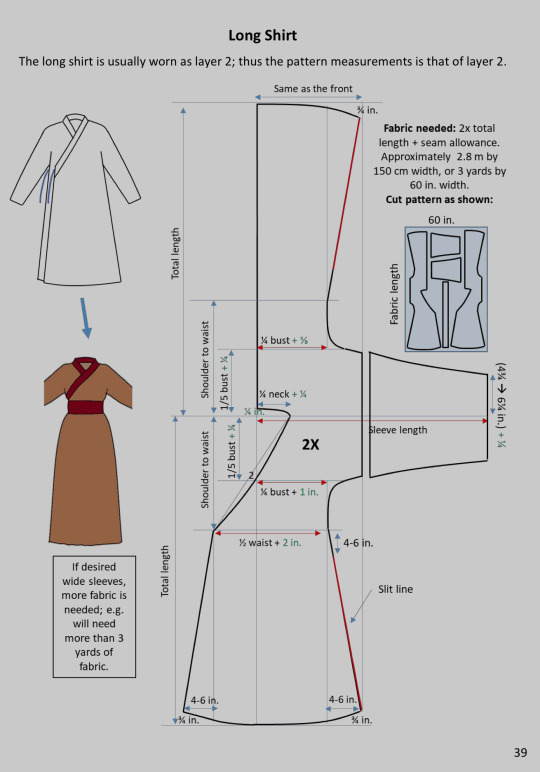
Most importantly, the book helps you estimate the total yardage of fabric you will need and instructs how to lay the pattern down on the fabric and how to cut it out according to the grain line and selvedge. This is critical for getting the correct draping effect with the fabric and will it allow to fit and flow better when you are wearing it. With the wider teardrop shaped sleeves, I decided on an extra yard of fabric. I’m still not sure if this will be enough - I may need to make it a little less curved and not quite as wide but I’ll update as necessary.
This requires you to draft your pattern ‘from scratch’ and I can already state that a mock-up will be essential. The guide also has estimates e.g. a curve of 4-6″ at the base so make sure you are consistent with your choices. I am going to give a suggested order of events on how to most efficiently establish your workflow.
Fabric selection:
Although a bit counter-intuitive, I chose to purchase my fabric first. After over thirty minutes of searching for good fabric matches from domestic suppliers ranging from Mood to JoAnn’s to my aunt’s sister’s shop, I realized it would be easier to [gasp] order fabric directly from China even with a variable shipping time. Plus, I could find patterns that are much closer matches to the original than anything here in the States.
I picked a bamboo fabric for the coat in a baby green color ordering 4m which is ~4 yards.

The fabric was in stock and shipped out fairly quickly and cleared customs without issue arriving 20 days faster than expected.
For the blue layer ( Zhiju/直裾 - straight-hem robe?) I went with this fabric with a leaf pattern. I choose it as a color match, not as a pattern match since I couldn’t find any fabrics in dusty blue with blades of grass. I also ordered 4m, again ~4 yards.

Unfortunately, this was still in production when I ordered it and I’m currently waiting for it to ship out. The seller has updated me on the status and I’m hoping it ships out soon. Update - my blue fabric arrived safely in the States, 1 day after the original predicted delivery date. Nice! I would highly recommend this fabric seller; excellent customer service.
The red layer ( Zhiju/直裾 - straight-hem robe?) I decided to save some money and purchase a cotton fabric locally at JoAnn’s. I wanted cotton since it breathes and something that looked close-ish but under $10/yard. I chose this cotton calico, which normally would be used for quilting, but the calicos have abstract patterns that mimic the patterns woven into silk. I bought 4 yards.
Update - I had to buy another 1.5 yards b/c I couldn’t quite fit my pieces; the fabric isn’t very wide and my sleeves were going to end up too short. Double check the width of your fabric. Unlike the imported fabrics this fabric was pretty short for width compared to other fabrics.

I may change my mind in the future and upgrade it also to silk but for right now I’m curious to see if it works out fine as it is only the second layer. For the white Zhong Yi/中衣 (middle clothes) first layer, I just got basic cotton twill, and purchased 3 yards. I’m not including a picture b/c it is just basic white cotton.
Lastly, I bought 4 yards of white cotton muslin at $6/yard to make a mock-up. Also no fun picture of crappy fabric for you.
Make sure to wash and iron all of your fabric before using! I washed the cotton on cold with an unscented detergent air-dried it and then ironed out major wrinkles.
Drafting the pattern:
Following the directions in Hanfu Pattern Making, I took a bunch of measurements of myself. This would likely be slightly more accurate if someone else did this for me, but I live alone and my cat isn’t capable of assisting me. The fact that the book tells you exactly what to measure and then how to apply it, is vastly easier than the link above (sorry likely Canadian engineer).
The measurements allow you to plug and play to generate your draft pattern. This was my first sketch, which is rough and not drawn to scale.
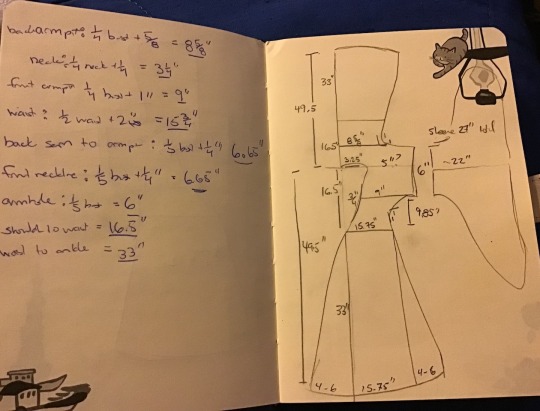
On the left you can see the measurement for various parts. Above was my first attempt for layer 2. For the flare at the base, I chose 4″ and followed the suggested 3/4″ curve.
back armpit measurement is equal to: 1/4 bust + 5/8″
my bust is 32″, so 1/4 is 8″ and I add 5/8″ to that = 8 and 5/8″ waist is equal to: 1/2 waist + 2″
my waist is 27.5″, so 13.75″ (13 and 3/4″) + 2″ = 15.75″ (15 and 3/4″)
Therefore, once you are done calculating the various measurements you can add them onto a rough sketch of the shape of the pattern. I choose to start with what the book refers to as layer 2 for my initial measurements. This is because I wanted to do the mock-up to correspond to the red second layer. I don’t think it matters which layer you decide to start from since you will either be adding or subtracting from a layer to change to the one above or below it.
With my Hokkaido cat notebook in hand, filled with my notes and numbers, I drafted the pattern. For drafting paper, I went to Target and bought gift wrapping paper as it has a grid pattern on the backside. This pattern is massive, even with my kitchen table, I still couldn’t fit all of it on my cardboard cutting guide! You can’t clearly see the grid on the ‘wrong’ side of the wrapping paper, but it is there. Since the wrapping paper wanted to curl, books were used on the corners and I didn’t need that many extra tools.

For drafting, I used a 2B pencil, the 2″ wide by 18″ long ruler with holes in the middle (from JoAnn’s) and the 12″ curve ruler. I also had a measuring tape to roughly mark of distance. I went over the pencil with a ballpoint pen once I decided on the lines and shape. The curve of the neckline was the hardest part. I made an X in the corner of the neck line and an X at the waistline point. I then connected this with a straight line and at the halfway point took the line in by 1/2″ (towards the side of the body). The suggestion of the book is 3/4″, but I decided to be a little more conservative. I then gently made the slight curve by hand so that the most curved point was by 1/2″. The armpit/shoulder is the next most difficult part. My sketch above isn’t quite correct, the 6″ should be doubled, 6″ for the front and 6″ for the back based on my measurements. You need to make sure that the armpit curves are in line with each other! I had the back one off and I had to erase it and redraw it.
I started with the initial curve of a 1″ armpit as suggested in the book. It says the curve can between 1/2″-2″. Note that the book is designed for a very small size range, from about 5′ to 5′5″ (152.4-165 cm) and I am 5′3″ (160 cm). To make the curve, I used the curved ruler to trace a nice smooth line. Just make sure you use the same part of the ruler e.g. 1″ to 3″ or 9″ to 12″ etc. I went with the curve that looked the best.
This pattern doesn’t include seam allowance - you will have to add that on when cutting. To be most accurate, trace the pattern onto your fabric. I like to use the removable fabric markers like these:

You can then use the other color to mark out dots along the fabric for seam allowance, like 5/8″. If you can’t use fabric markers there are also removable mechanical pencils that come in yellow, magenta or you can be old school and use chalk. I transferred the pattern to the cheap cotton muslin fabric and cut it out. There aren’t many seams to sew and I ignored the sleeves since I wanted to determine if the pattern fit me well. I placed the right sides together and first sewn together the back seam. After that I did the armpit/side seams, leaving the armpit unfinished on the end and check the fit. Already you can see that the neckline isn’t laying flat and the armpits are super tight.

I just grabbed a long scarf to tie it down and adjust the fit at the waist.
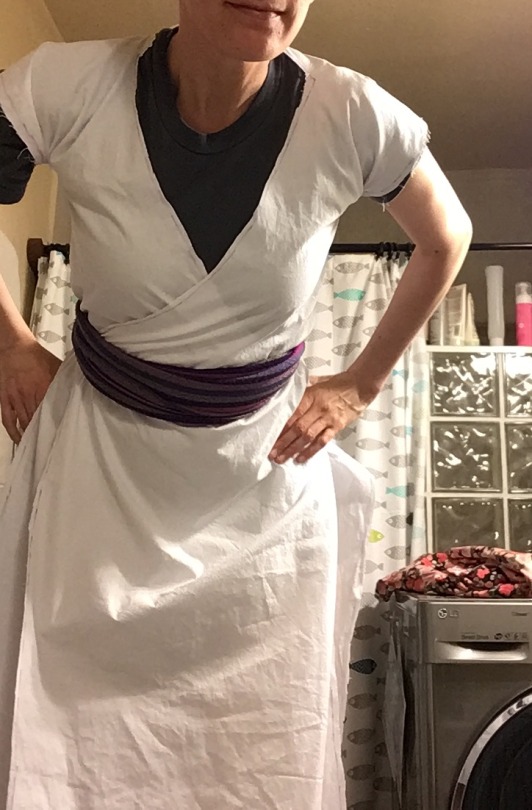
Leaning forward you can see the neckline is even more of a mess and the armpits are far to tight even though I am wearing a fitted t-shirt underneath (as this is layer two).
I went back to the drawing board to adjust the pattern. I kept my original pattern and added more paper to the armpit and neckline area to draft a new pattern and cut it out instead of a completely new draft since the waist down was totally fine, falling around my ankles.
This time I made a 2″ curve for the armpit, added more length to the armpit as well and only sewed the top with some scrap blue fabric. As you can see here, it was a more optimal armpit fit.

I also shifted the neckline curve to reduce it to 1/4″ instead of the 1/2″ from the first mock up. This was an excellent decision as it fit in the chest area much better. This is my sketch to reshape the neckline.

This is how it looked on me. Excellent!
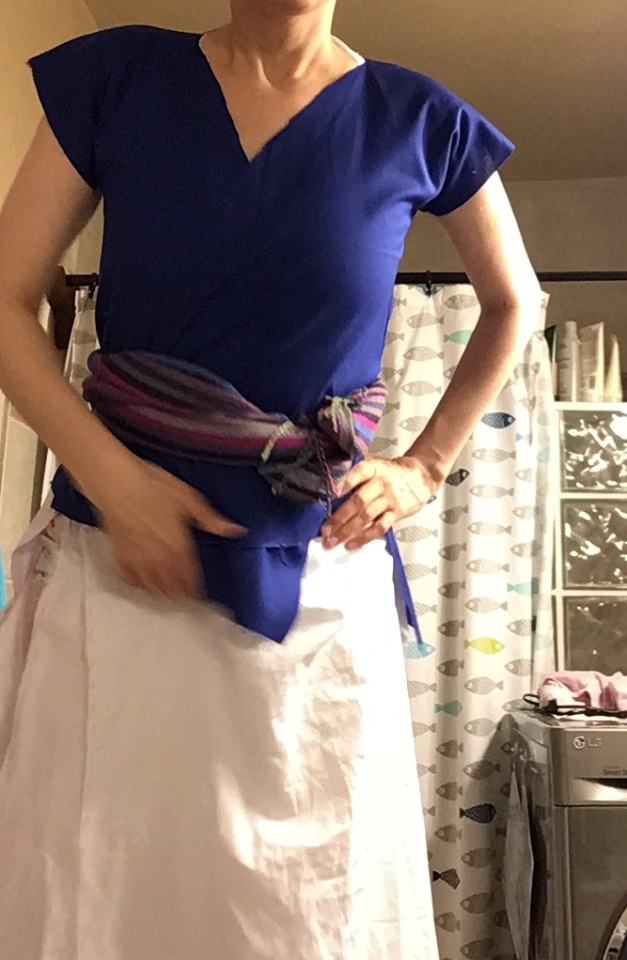
The neck still looks wide because I haven’t added the neck placket but the fabric lays much more naturally. My conclusion to date is that if you don’t have a very large bust size, err on the side of making the neckline less curved.
What I also concluded from this mock up is that my measurements for layer 2 are more likely my layer 1 measurements since they were quite form fitting on top.
The next step (backwards compared to the suggested order in the book) was to add sleeves. I guessed what shape would work best and my first draft was terrible as shown here.

The bottom was too square and I was trying to figure it out based on this scene from the drama. I chose this model for the sleeve since you can tell that the white layer in WKX’s outfits has a relatively wide sleeve.
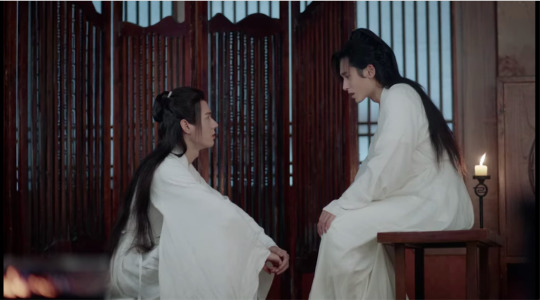
The only part that I used the pattern for reference was how to attach it to the armpit at the shoulder. The overall sleeve shape was just what I thought looked nice. Keep in mind that the shoulder seam sits fairly low on the shoulder compared to a modern garment. The seam line is a few inches down from the shoulder and you can see that the garment will naturally pucker in front of the armpit. In his several days of drunken sulking, you can see the seam line is even with the back of the chair.
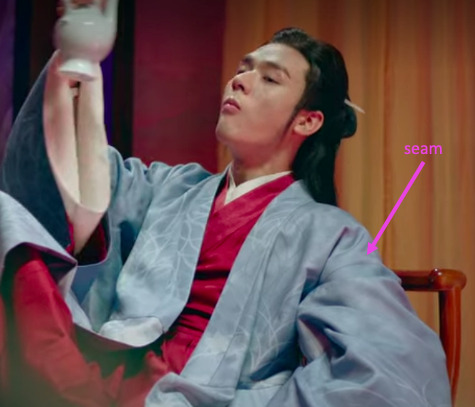
The weight of the sleeve itself helps to hold the shoulder structure and it doesn’t pop up as you see on my second mock-up with the blue fabric.
I drastically reduced the size of the sleeve curve and made a pattern based on something that seemed alright. With all of this mock-up work done, I decided to turn to making the first layer, the Zhong Yi/中衣 which I have summarized as a separate post.
#stickey#wen kexing#word of honor#sha he ling#WOH#shl#hanfu#cdrama#cdrama dress#pattern drafting#sewing#cosplay#sticky
264 notes
·
View notes
Link

#private label clothing manufacturers Canada#wholesale garments suppliers in Canada#clothing suppliers Canada
0 notes
Text
Congratulations on the successful launch of Top Best Apparel CO.,LTD. website!
Congratulations on the successful launch of Dongguan Top Best Apparel CO.,LTD. website! Thank you Jindo Information Technology (Shanghai) Co., Ltd. for its technical support to our website.
Welcome new and old friends to visit the website.HELLO, We are from Dongguan Top Best Apparel CO.,LTD, a professional sportswear manufacturing factory incorporates design, development, prodution and sales. Located in the so-called “City of Cloths”-Humen, the company is only one-hour drive to Guangzhou, Shenzhen and Hongkong.
The company ‘s strengths:
1.Covering a floor area of 2000 sqms, we have 3 designers, 4 pattern makers, 8 senior international sales person and 78 workers.
2.MOQ is 100pcs for customized orders. Daily capacity is 7000pcs, and monthly production capacity is over 100 thousand pcs. We also have stock, so if your order is small quantity, we can also fullfill your requirements.
3.Most of our clients are from18 countries and districts around the world including US, european countries, Canada, Korea etc. We have the most professtional knowhow for quality requirements for fitness cloths and transportation process.
4.We can accept payment terms like Trade ssurance, T/T, Wire Transfer,Paypal, Western Union, Money Gram etc.
5.Ownning a high-efficient management team, including desing, pattern making, production, checking, packing, QC, Transportation etc, so as to ensure high quality for the product and high efficiency for transportation.
6. Aiming to provide clients with the best quality, high effiency, the most comfortation and the best healthy cloths, giving escort to your daily gym exercises. We welcome clients from all industries arround the world. If you are looking for a reliable garment supplier now, pls contact us and we will do our best to provide you with the best servise and sincerely looking forward to establish long-term relationship with you.
Our contact information is as follows:
Contact: Mr. Huang
Mobile: 13588975192
Email: [email protected]
Address: Nanshaao Industrial Zone, Liushi Town, Yueqing, Wenzhou, Zhejiang Province
1 note
·
View note